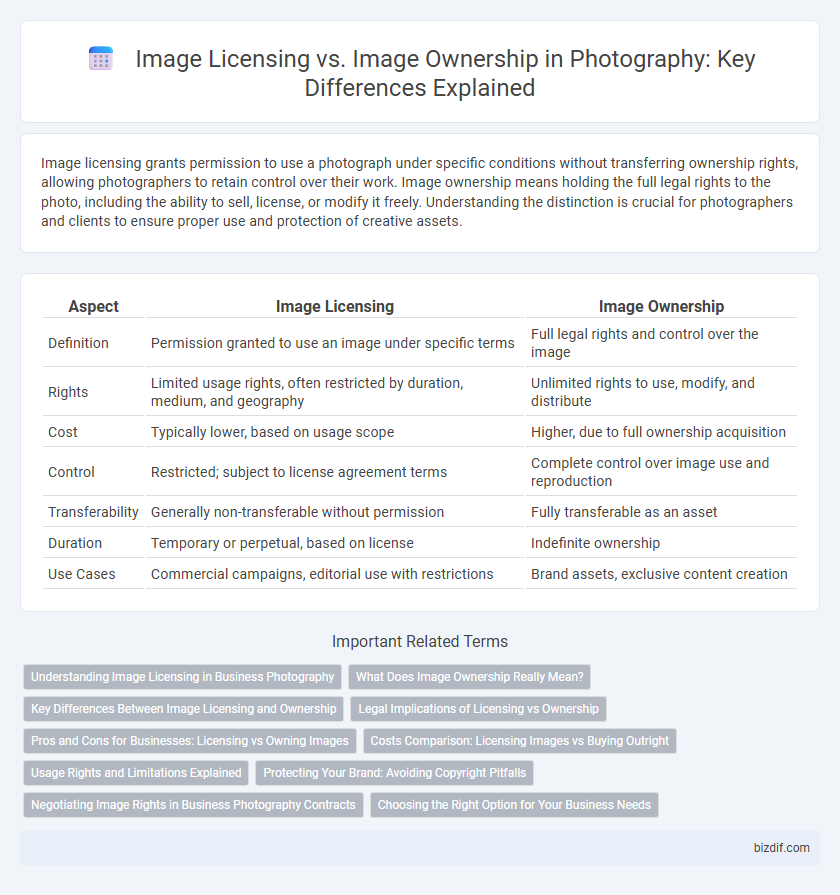Image licensing grants permission to use a photograph under specific conditions without transferring ownership rights, allowing photographers to retain control over their work. Image ownership means holding the full legal rights to the photo, including the ability to sell, license, or modify it freely. Understanding the distinction is crucial for photographers and clients to ensure proper use and protection of creative assets.
Table of Comparison
| Aspect | Image Licensing | Image Ownership |
|---|---|---|
| Definition | Permission granted to use an image under specific terms | Full legal rights and control over the image |
| Rights | Limited usage rights, often restricted by duration, medium, and geography | Unlimited rights to use, modify, and distribute |
| Cost | Typically lower, based on usage scope | Higher, due to full ownership acquisition |
| Control | Restricted; subject to license agreement terms | Complete control over image use and reproduction |
| Transferability | Generally non-transferable without permission | Fully transferable as an asset |
| Duration | Temporary or perpetual, based on license | Indefinite ownership |
| Use Cases | Commercial campaigns, editorial use with restrictions | Brand assets, exclusive content creation |
Understanding Image Licensing in Business Photography
Image licensing grants businesses permission to use photographs under specific terms without transferring ownership, enabling control over usage rights and duration. Understanding licensing agreements helps photographers protect their work while providing clients the flexibility to use images for marketing, advertising, or editorial purposes. Clear licensing terms prevent unauthorized reproduction and ensure proper compensation for commercial use of business photography.
What Does Image Ownership Really Mean?
Image ownership means having the legal rights to control, use, modify, and distribute the photograph, typically held by the creator or photographer unless transferred. This ownership grants exclusive copyright status, enabling the owner to license the image to others while retaining ultimate control over its reproduction and usage. Understanding the distinction between ownership and licensing is crucial for photographers to protect their intellectual property and monetize their work effectively.
Key Differences Between Image Licensing and Ownership
Image licensing grants permission to use a photograph under specified conditions without transferring ownership rights, allowing control over reproduction, distribution, and modification. Ownership of an image confers full legal rights, including exclusive control over its use, sale, and the ability to enforce copyright protections. Licensing agreements often define usage scope, duration, and geographic limits, whereas ownership provides indefinite rights and complete authority over the image.
Legal Implications of Licensing vs Ownership
Image licensing grants specific usage rights to a licensee while the photographer retains copyright ownership, limiting unauthorized exploitation and ensuring legal recourse in case of misuse. Ownership of an image includes full control over reproduction, distribution, and modification rights, imposing stricter legal obligations but offering broader authority and protection under intellectual property laws. Understanding the distinction is critical to navigating contract terms, avoiding infringement disputes, and securing proper compensation in professional photography.
Pros and Cons for Businesses: Licensing vs Owning Images
Image licensing offers businesses flexibility and cost-effectiveness by granting usage rights without the need for outright purchase, allowing access to a broad range of professional photographs tailored for specific marketing campaigns. However, licensing restrictions can limit usage scope, duration, and exclusivity, potentially leading to additional fees or legal risks if terms are exceeded. Owning images provides full control and perpetual rights, enabling unrestricted use and customization, but involves higher upfront costs and resource investment in photography production and management.
Costs Comparison: Licensing Images vs Buying Outright
Licensing images typically involves recurring fees or usage-based costs, making it more affordable for short-term projects or limited use. Buying an image outright requires a higher one-time payment but eliminates future licensing fees and grants full ownership rights. Evaluating project scope and long-term usage helps determine whether licensing or purchasing outright offers better cost efficiency in photography.
Usage Rights and Limitations Explained
Image licensing grants specific usage rights while ownership confers full control over the image, allowing unrestricted use, reproduction, and modification. Licensing agreements typically define limitations such as duration, geographic region, and permissible media, ensuring the licensee uses the image only within agreed boundaries. Understanding these distinctions protects photographers' intellectual property and guides clients in lawful image utilization.
Protecting Your Brand: Avoiding Copyright Pitfalls
Understanding the distinction between image licensing and image ownership is crucial for protecting your brand and avoiding copyright pitfalls. Licensing grants permission to use an image under specific terms while ownership provides full control and rights over the image's usage. Securing proper licenses or owning the rights outright ensures legal compliance and safeguards your brand from infringement claims and unauthorized use.
Negotiating Image Rights in Business Photography Contracts
Negotiating image rights in business photography contracts requires clear definitions of licensing terms versus ownership to protect both parties. Licensing grants specified usage rights without transferring copyright, allowing photographers to retain control while clients gain authorized use. Detailed agreements should outline duration, exclusivity, scope, and territory of image use to prevent disputes and maximize value for commercial projects.
Choosing the Right Option for Your Business Needs
Image licensing grants businesses specific usage rights without transferring full ownership, allowing flexibility in promotional materials while managing costs. Image ownership provides complete control and unlimited use, which is ideal for brands seeking long-term exclusivity and content customization. Evaluating your marketing strategy and budget will help determine whether licensing or owning images best supports your business goals.
Image licensing vs Image ownership Infographic

 bizdif.com
bizdif.com